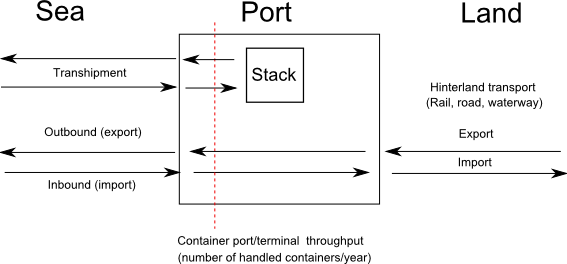Transshipment (or transhipment) is a term used for shipment of goods to an intermediate destination before being shipped to its final destination. It is not restricted only to shipping; transshipment can take place through road, rail and air transport as well.
To understand this, let’s consider some commuting examples that many of us will relate to. People who live in Delhi are familiar with the Delhi Metro, so someone commuting from Kailash Colony to Saket on the metro will have to changeover from Central Secretariat station to reach their destination. Similarly a person from Mumbai will be aware that to get from Thane to Mumbai Central, they need to switch trains from Dadar station. All stations are connected to one another but at times there’s no direct route available. This is the same problem faced by cargo as well and transshipment becomes a major part of shipping logistics.
There are several reasons for using transshipment. These are as follows:
- The distance between port of origin of cargo and its destination may be too far. A single direct service is often unavailable in such cases.
- The shipment might be on a Less-than Container Load (LCL) basis, leading to changeover of parcel in the containers to a different container so that consolidation of goods going to the same port can take place.
- Larger vessels carry a lot more cargo and benefit from economies of scale. However these vessels cannot berth at smaller ports and transshipment is the logical way to move forward. Direct shipping by large vessels is justified only if a major portion of the cargo is being traded at that port.
- It permits customization in the cargo handling to meet specific local, packaging requirements which can be accomplished at an intermediate port where cost of such operation is much lesser.
- The use of real-time communication through internet and other wireless media has simplified the operational and transaction management aspect of transshipment and made it much more effective.

Transshipment can sometimes be confused with transloading. When the mode of transport changes from, say a truck to a train, the shipment is said to be transloaded. The process is still specified as a single shipment till it reaches its destination. In transshipment, it is not necessary that the cargo change its mode of transport however, the cargo reaches its destination through an intermediate stoppage and these stoppages are considered as separate shipments.
Major shipping lines likes MSC and Maersk have services that cover almost all the ports in the world via connecting ports. These ports are known as transshipment hubs. To make transshipment viable, certain difficulties have to be overcome such as additional handling costs, port charges and extra voyage distances. Biggest reason for a port becoming hub is its location, infrastructure to handle additional cargo loading and unloading operation and tax benefits. To lure more transshipped cargo to its port, Rotterdam port, in 2014, announced triple discount on tariffs for deep sea containers going to other ports in Europe.
Top 5 hubs for year 2009 are mentioned below:
| Port Name | Country | Total TEUs (in 000s) | Transshipped TEUs (in %) |
| Singapore | Singapore | 25,867 | 82 |
| Hong Kong | China | 21,040 | 30 |
| Shanghai | China | 25,602 | 43 |
| Dubai | UAE | 11,129 | 50 |
| Busan | South Korea | 11,955 | 42 |
Source: Compiled from various sources
All these hubs are within Asia as China and Japan are large exporters of containerized cargo. Rotterdam port in Netherlands, Gioia Tauro in Italy, Algeciras in Spain and Hamburg in Germany are major hubs outside of Asia. The port of Jamaica acts as hub for America bound containers.
As far as India is concerned, 80% of its containers that come via transshipment are through Port of Colombo in Sri Lanka. Jebel Ali port in Dubai and Salalah port in Oman act as hubs for Middle Eastern region. Most of the container traffic in India is handled by the Jawaharlal Nehru Port in Navi Mumbai and Cochin port in Vallarpadam. India has great opportunity to become a hub with the Vizhinjam Port and attract transshipped containers going to Colombo and Hong Kong. Vizhinjam has advantages like natural deep draft of 20 meters and the international east-west shipping route is a mere 10 nautical miles from the port. In India, customs duty on imported goods meant for transshipment is waved off. The importer must declare the goods as transshipment cargo to make use of this customs act.
Transshipment has many logistical benefits, but it can be used by smugglers and terrorists to disguise the port of origin. Countries like Libya, North Korea and Syria pose a higher security threat while China and Taiwan are known for interchange of counterfeit goods. Transshipments are mostly intentionally done to avoid paying higher taxes and to make use of special trade programs. However, accidental transshipments also take place due to miscommunication.